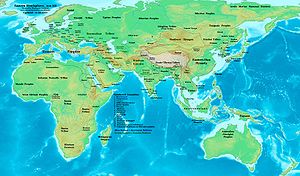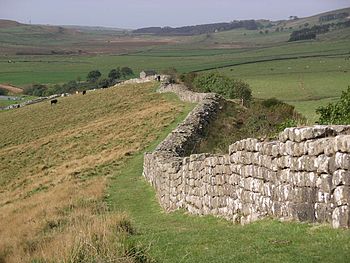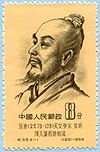
2nd century
Did you know...
The articles in this Schools selection have been arranged by curriculum topic thanks to SOS Children volunteers. Child sponsorship helps children one by one http://www.sponsor-a-child.org.uk/.
| Millennium: | 1st millennium |
|---|---|
| Centuries: |
|
| Decades: | 100s 110s 120s 130s 140s 150s 160s 170s 180s 190s |
| Categories: | Births – Deaths Establishments – Disestablishments |
The 2nd century is the period from 101 to 200 in accordance with the Julian calendar in the Common Era. It is considered part of the Classical era, epoch, or historical period
Early in the century, the Roman Empire attained its greatest expansion under the emperor Trajan, but after his death became primarily defensive for the rest of its history. Much prosperity took place throughout the empire at this time, ruled as it were by the Five Good Emperors, a succession of just and able rulers. This period also saw the removal of the Jews from Jerusalem during the reign of Hadrian after Bar Kokhba's revolt. The last quarter of the century saw the end of the period of peace and prosperity known as the Pax Romana at the death of the emperor Marcus Aurelius, last of the " Five Good Emperors", and the accession of his ineffective and deranged son Commodus.
Although the Han Dynasty of China was firmly cemented into power and extended its imperial influence into Central Asia during the first half of the century, by the second half there was widespread corruption and open rebellion. This set in motion its ultimate decline, until it was overthrown in 220.
Events
- 96 – 180: Five Good Emperors of Rome: Nerva, Trajan, Hadrian, Antoninus Pius, Marcus Aurelius.
- The Kingdom of Aksum emerges.
- 115 – 117: Kitos War, adjunct to the Jewish–Roman wars.
- 122 – 132: Hadrian's Wall across Britain.
- 132 – 135: Bar Kokhba's revolt against Rome.
- 144: Marcion, rejected by Church of Rome, founds Marcionism.
- 161 – 166: Roman–Parthian War of 161–166.
- 167 – 175: First Marcomanni War.
- 178 – 180: Second Marcomanni War (depicted in the movie Gladiator).
- 180 – 192: Commodus, Roman Emperor.
- 184 – 205: the Yellow Turban Rebellion of the Han Dynasty in China begins.
- 193: Roman Year of the Five Emperors.
- 193 – 211: Septimius Severus, Roman Emperor.
- Herakleitos makes The Unswept Floor, mosaic variant of a 2nd-century BC painting by Sosos of Pergamon. It is now kept at Musei Vaticani, Museo Gregoriano Profano, ex Lateranese, Rome.
- c. 2nd or 3rd century – Standing Buddha, from Gandhara (Pakistan), is made. Kushan period. It is now kept at Lahore Museum, Lahore.
Significant people
- Cai Lun, the inventor of paper and the papermaking process.
- Trajan, Roman Emperor.
- Hadrian, Roman Emperor.
- Dr Abascantus, Doctor.
- Marcus Aurelius, Roman Emperor.
- Rabbi Akiva, Head of all the Jewish Sages.
- Rabbi Yehuda haNasi, Prince of the Jewish people.
- Commodus, Roman Emperor, claimed to be Hercules reincarnated.
- Galen, medical writer.
- Ignatius, third bishop of Antioch, author of letters.
- Irenaeus, second bishop of Lyon, author of Against the Heresies.
- Juvenal Roman satirical poet.
- Lucian of Samosata (c. CE 125 – after CE 180), rhetorician and satirist who wrote in the Attic Greek language.
- Montanus, Christian heretic.
- Nagarjuna, founder of Madhyamaka Buddhism.
- Pliny the Younger.
- Plutarch, Greek historian.
- Polycarp, bishop of Smyrna.
- Ptolemy, Greek astronomer, astrologer and geographer.
- Septimius Severus, Roman Emperor.
- Suetonius, Roman historian.
- Valentinius, Gnostic philosopher.
- Victor I, bishop of Rome.
- Zhang Daoling, Chinese Taoist hermit.
- Zhang Heng, Chinese statesman, poet, inventor, astronomer, geographer, and engineer.
- Zhang Zhongjing, one of the most famous Chinese physicians during Han Dynasty.
Inventions, discoveries, introductions
- Cai Lun of China invents paper (c. 105).
- Ptolemy compiles a catalogue of all stars visible to the naked eye. He also compiles three of the most influential books in western history:
- the Almagest which becomes the basis for western and Middle Eastern astronomy until the time of Nicolaus Copernicus and Johannes Kepler.
- the astrological treatise, Tetrabiblos.
- and the Geographia.
- 125: Zhang Heng of China invents the world's first water-powered armillary sphere.
- 132: Zhang Heng of China invents first seismometer to detect the cardinal direction of earthquakes.
|
|||||||||||||||||||||||||||||||||||||||||||||||||||||||||||||||||||||||||||||||||||||||||||||||||||||||||||||||||||||||||||||||||||||||||
|
|||||||||||||||||||||||||||||||||||||||||||||||||||||||||||||||||||||||||||||||||||||||||||||||||||||||||||||||||||




